Have you ever felt trapped in a cycle of diets and cardio, striving for weight loss but seeing minimal results? The frustration is real, but what if there’s a game-changer hiding in plain sight?
Enter strength training, the unsung hero of the weight loss journey.
While it might not be the first thing that comes to mind when aiming to shed pounds, its potential to rev up your metabolism and sculpt your physique is unparalleled.
According to studies published in the National Library of Medicine, combining strength training with a balanced diet can lead to significant weight loss and a reduction in body fat percentage [*].
But here’s the kicker: it’s not just about the numbers on the scale.
Strength training helps you lose fat while preserving precious lean muscle mass, a crucial factor for sustainable weight loss and long-term health.
So, if you’re ready to break free from the cycle and unlock your body’s true potential, it’s time to delve into the basics of strength training for weight loss.
Understanding Strength Training for Weight Loss
Let’s face it, traditional weight loss advice can feel like a never-ending cycle of restrictive diets and relentless cardio.
You might even be picturing yourself pounding the pavement for hours, only to see the numbers on the scale budge ever so slightly.
But what if there was a hidden weapon in your weight loss arsenal, something that could boost your metabolism, sculpt your physique, and leave you feeling energized?
Enter strength training, often the misunderstood hero of the weight loss journey.
What is Strength Training, and Why Should You Care?

Strength training, also known as resistance training, involves working your muscles against a form of resistance, like dumbbells, barbells, or even your bodyweight.
Here’s the magic: as you challenge your muscles to adapt and grow stronger, your body increases its metabolic rate, even at rest.
This means you burn more calories throughout the day, even while you’re catching up on your favorite show – talk about a win-win!
A research review published in the Journal of Strength and Conditioning Research [2] found that strength training alone can lead to an average weight loss of 3-4 pounds over several months.
That might not sound like a huge number, but here’s the kicker: strength training helps you lose fat specifically while preserving lean muscle mass.
This is crucial because muscle burns more calories than fat, further amplifying your weight loss efforts in the long run.
Cardio or Strength Training: Why Not Both?
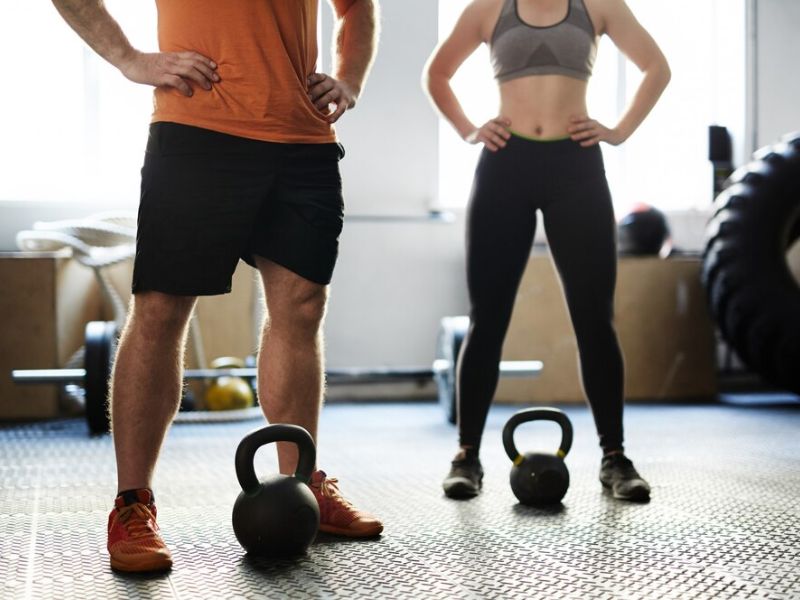
While strength training is a powerhouse for building muscle and boosting metabolism, don’t ditch cardio entirely. Think of it as the sidekick to your strength training hero.
Cardio helps you burn calories DURING your workout, improves heart health, and increases lung capacity. But the key is to find the right balance.
Research suggests that combining moderate-intensity cardio with strength training can lead to the most significant weight loss and overall health benefits [*].
Benefits of Strength Training:

Let’s face it, stepping on the scale and seeing that stubborn number budge can be incredibly motivating.
But what if strength training offered a secret weapon that went way beyond the number on the scale?
Imagine a world where exercise not only helps you lose weight but also keeps your bones strong, your mood bright, and your body a powerhouse of potential.
Resistance training, offers a treasure trove of benefits that extend far beyond weight loss.
Scenario: Picture Sarah, a busy working mom who finally shed some pounds with diet and cardio. But lately, she feels a nagging pain in her knees and struggles carrying groceries.
Strength training to the rescue!
Benefit #1: Building a Calorie-Burning Machine (and It’s Not Just About Looking Toned!)

Remember that stubborn jiggle? It’s mostly fat tissue, which burns minimal calories at rest.
Strength training, builds muscle mass.
Here’s the exciting part: muscle is metabolically active, meaning it burns more calories even while you’re catching up on Netflix!
A study published in the American College of Sports Medicine found that people who added strength training to their routine burned an average of 100 more calories per day, even at rest [*].
That’s like effortlessly burning off an entire candy bar each day!
Benefit #2: Stronger Bones, Fewer Worries
Imagine feeling confident knowing your bones are strong and resilient. Strength training doesn’t just sculpt muscles; it strengthens your bones too.
As we age, bone density naturally decreases, raising the risk of fractures.
Research shows that regular resistance training can significantly increase bone mineral density, especially in the hips and spine, reducing the risk of osteoporosis [*].
This translates to a more active, independent life for years to come.
Benefit #3: Unleashing Your Inner Athlete (Even if You Think You’re Not One!)

Remember those days when climbing a flight of stairs left you breathless? Strength training can change that.
By building stronger muscles, you improve your overall strength, endurance, and power. This translates to better performance in everyday activities, from carrying groceries to playing with your kids.
Plus, it can enhance your athletic performance in any sport you enjoy, making you a more well-rounded athlete.
Benefit #4: From Stressed to Strong: The Mind-Body Connection

Feeling overwhelmed by daily life? Strength training can be your secret weapon for mental well-being.
Studies have shown that resistance training can significantly reduce stress and anxiety, while also boosting mood and self-esteem [*].
That post-workout feeling of accomplishment is a real mood booster!
Strength training also helps you sleep better, which is crucial for overall mental and physical health.
Want to unlock a world of fitness benefits? Dive deeper into the 10 Strength Training Benefits you can expect to experience, from building muscle to boosting your mood
Getting Started with Strength Training

So, you’re ready to embark on the strength training journey – awesome! But let’s face it, stepping into a gym for the first time can be intimidating.
Weights seem like a foreign language and proper form feels like a mystery. But fear not, because getting started with strength training is way more approachable than you think.
Let’s break it down and get you lifting (safely!) in no time.
Safety First: The Importance of Proper Form

Think of proper form as your superpower in strength training.
It unlocks amazing results while keeping you injury-free. Here’s the thing: using the wrong form might not give you the results you desire, and worse, it can lead to aches and pains.
Imagine Sarah, who started weightlifting with enthusiasm but ended up with back pain because she wasn’t squatting correctly. A bummer, right?
The good news is, proper form is learnable! Here are some tips:
- Start light: Don’t try to impress anyone (or yourself) with heavy weights initially. Lighter weights with proper form will yield better results and prevent injury.
- Focus on technique: Pay attention to your posture, core engagement, and the targeted muscle group during each exercise. Don’t hesitate to ask a trainer or gym staff for guidance if needed.
- Mind the body-weight exercises: Even bodyweight exercises like squats and lunges require proper form. Mastering these will build a solid foundation for weight training later on.
Finding Your Perfect Fit: The Equipment Arsenal
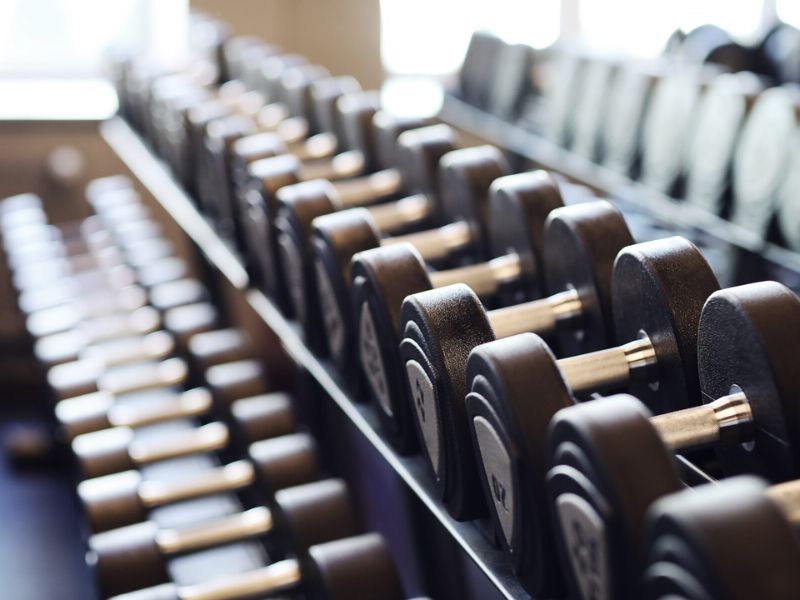
The gym might seem like a land of fancy equipment but don’t feel pressured to use everything at once. Here’s a breakdown of some essential tools to get you started:
- Bodyweight Exercises: These are your free pass to a fantastic workout. Squats, lunges, push-ups, planks, and rows are incredibly effective for building strength without any equipment.
- Dumbbells: These versatile weights allow you to target various muscle groups with a wide range of exercises. Start with lighter weights you can comfortably control for 10-12 repetitions.
- Resistance Bands: Affordable and portable, Resistance bands offer a great way to add variety and challenge to your workouts. They come in different resistance levels, so you can choose the right band for your strength.
Interactive Challenge: Warm-up and Cool-down for Success

Just like your car needs a warm-up before hitting the highway, so does your body! A proper warm-up preps your muscles for exercise and reduces the risk of injury. Here’s a simple warm-up routine you can do before your workout:
- 5-minute light cardio: Get your blood flowing with brisk walking, jumping jacks, or jogging on the spot.
- Dynamic Stretches: These stretches involve movement, preparing your muscles for the workout ahead. Try arm circles, leg swings, and torso twists.
Once you’ve finished your workout, a cool-down routine helps your body return to its resting state and improves flexibility. Here are some cool-down exercises to try:
- Static Stretches: Hold these stretches for 15–30 seconds each, focusing on major muscle groups like your legs, back, and shoulders.
- Deep Breathing: Take slow, deep breaths for a few minutes to calm your mind and body.
Exercise Guides:
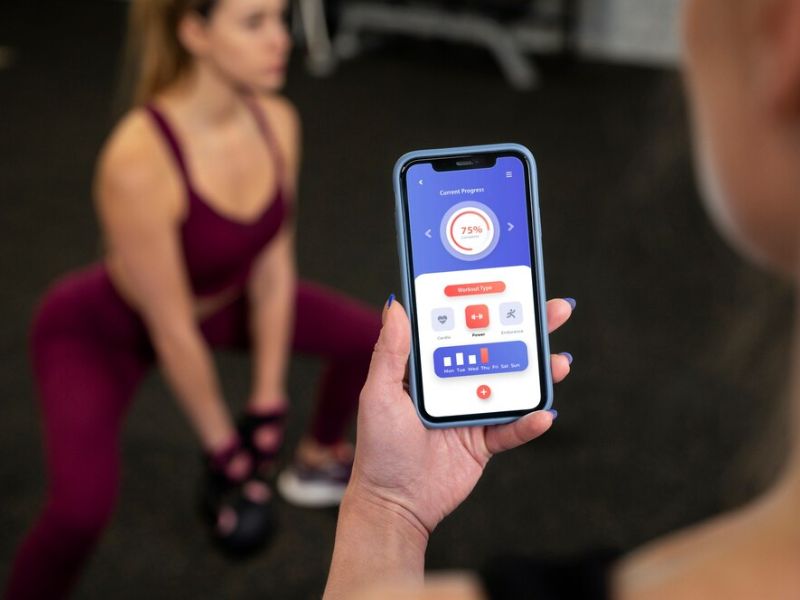
Picture this: You’ve conquered the gym initiation and mastered proper form. Now you’re ready to dive into the exciting world of strength training exercises.
But where do you even begin? Don’t worry, this guide will be your roadmap to building a strong foundation with beginner-friendly gym exercises targeting different muscle groups.
Building Your Strength Arsenal: Exercises for a Full-Body Blast
Think of these exercises as building blocks for a sculpted physique. Remember, start light and prioritize proper form over ego. Here are 5 exercises for each major muscle group, perfect for beginners:
Chest:

- Dumbbell Bench Press: Lie flat on a bench, holding dumbbells at chest level. Press the weights straight up, then lower back down with control.
- Dumbbell Flyes: Lie on a bench with dumbbells raised at shoulder height. Open your arms in a wide arc, then lower them back down with control.
- Incline Dumbbell Press: Adjust the bench to an incline position and perform the dumbbell bench press as described above. This targets the upper chest.
- Decline Dumbbell Press: Set the bench to a decline position and perform the dumbbell bench press. This targets the lower chest.
- Chest Press Machine: If free weights feel intimidating, try the chest press machine. Sit down, adjust the weight, and push the handles forward to engage your chest.
Back:

- Seated Cable Row: Sit facing a cable row machine, grasp the handle, and pull it towards your chest, squeezing your back muscles.
- Lat Pulldown: Sit on a lat pulldown machine, grip the bar, and pull it down towards your chest. This targets your lats, the large muscles in your upper back.
- Barbell Deadlift (modify with dumbbell deadlifts if preferred): Stand with feet hip-width apart, hold a barbell (or dumbbells) with a straight back and knees slightly bent. Lower the weight down your legs, keeping your back straight, then raise it back up to the starting position.
- Seated Cable Row (variation): To target your mid-back, adjust the cable row machine to a higher setting and perform the seated cable row as described above.
- Pull-Ups (assisted machine or with resistance bands if needed): This classic exercise works your entire back. If regular pull-ups are too challenging, use an assisted pull-up machine or resistance bands for support.
Legs:
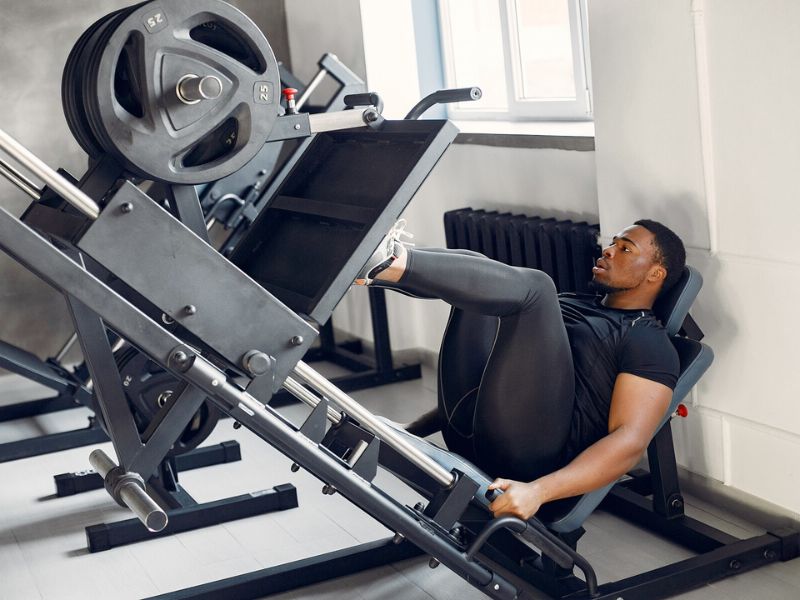
- Leg Press: Sit on a leg press machine, position your feet shoulder-width apart on the platform, and press the weight forward to extend your legs.
- Hamstring Curl: Lie on a hamstring curl machine, secure your legs under the pads, and curl your heels towards your glutes.
- Leg Extension: Sit on a leg extension machine, secure your ankles under the pads, and extend your legs straight out in front of you.
- Barbell Squats: Stand with feet shoulder-width apart, hold a barbell across your upper back (or dumbbells at your shoulders), and squat down as if sitting in a chair, keeping your back straight and core engaged.
- Calf Raise: Stand on a calf raise machine or a step, raise your heels up onto your toes, then lower back down with control.
Building Your First Full-Body Workout:

Now that you have a taste of some beginner-friendly exercises, let’s put them together into a simple yet effective full-body workout routine.
Aim to perform 2-3 sets of 10-12 repetitions for each exercise, with a short rest period (30–60 seconds) in between sets.
Remember, this is just a sample, and you can adjust it based on your comfort level and equipment availability.
Warm-up (5 minutes):
- Light cardio (brisk walking, jogging on the spot)
- Dynamic stretches (arm circles, leg swings, torso twists)
Workout:
- Dumbbell Bench Press (3 sets of 10-12 reps)
- Seated Cable Row (3 sets of 10-12 reps)
- Leg Press (3 sets of 10-12 reps)
- Dumbbell Flyes (3 sets of 10-12 reps)
- Plank (3 sets of 30-60 seconds hold)
Cool-down (5 minutes):
- Static stretches (hold for 15-30 seconds each, focusing on major muscle groups)
- Deep breathing
What is Progression and Why Does It Matter?

Imagine this: You’re cruising through your beginner’s workout routine.
You’re feeling stronger, and more confident, and those initial aches have faded.
But then, a dreaded feeling creeps in – a plateau. You’re lifting the same weights, performing the same reps, and… NOTHING.
Don’t worry, this is a natural part of the strength training journey. But fear not, fellow fitness warriors.
This is where the concept of progression comes in, your secret weapon for blasting through plateaus and unlocking new levels of strength.
Think of your muscles like adaptable little ninjas. They get used to challenges, and once they master a routine, they stop seeing significant improvement.
Progression throws them a curveball, keeping them guessing and forcing them to adapt and grow stronger.
Here are some ways to incorporate progression into your workouts and keep those ninja muscles on their toes:
- The Weightlifter (Adding More Weight): This might seem obvious, but it’s a classic progression technique for a reason! Once you can comfortably perform an exercise for the designated number of repetitions (usually 8-12 reps), it’s time to increase the weight slightly. Don’t go overboard; a small bump in weight is all you need to keep challenging your muscles without compromising form.
- The Marathoner (Adding More Sets): Let’s say you’re currently doing 2 sets of 10 dumbbell bench presses. Feeling strong? Consider adding another set to your routine! This increases the overall workload on your muscles, pushing them to work harder and build more strength.
- The Speed Demon (Decreasing Rest Time): As your stamina improves, shorten those rest periods between sets! This might sound intimidating, but decreasing rest from 60 seconds to 45 seconds can significantly increase the intensity of your workout. Just be sure you’re maintaining good form throughout.
Nutrition and Weight Loss:

Imagine this: You’re crushing your strength training workouts, feeling stronger and more confident. But then, the scale seems stuck, and frustration sets in.
Could it be your diet holding you back?
Absolutely. Nutrition is the missing puzzle piece in your weight loss and muscle-building journey.
But fear not, because this guide will equip you with the knowledge to fuel your body with delicious, Indian-inspired meals that support your strength training goals.
The Macro Magic: Understanding Your Nutritional Needs
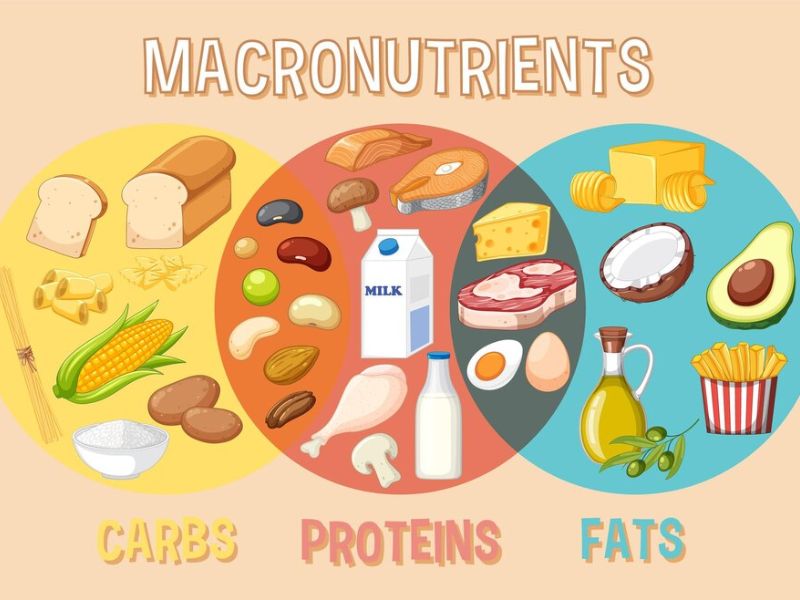
Think of your body as a high-performance car. It needs the right fuel to run efficiently. Macronutrients – protein, carbs, and fats – are the building blocks of that fuel. Here’s a breakdown of their importance:
- Protein: The superstar for muscle building and repair! Aim for 0.8-1 gram of protein per pound of bodyweight daily. Include protein sources like chicken, lentils (dal), fish, eggs, and paneer in your diet.
- Carbs: Your body’s primary energy source. Complex carbs like brown rice, whole-wheat rotis, sweet potatoes, and vegetables provide sustained energy for your workouts.
- Healthy Fats: Don’t ditch fats entirely! They play a crucial role in hormone production and feeling satiated. Focus on healthy fats like nuts, seeds, avocados, and olive oil.
Building Your Plate – Sample Meal Plans with an Indian Twist!

Now that you understand the importance of macronutrients, let’s put them into action! Here are some sample meal plans with different calorie levels, all featuring delicious dishes:
Weight Loss (1500 Calories):
- Breakfast: Besan cheela (gram flour pancake) with chopped veggies and a glass of low-fat milk.
- Lunch: Small bowl of brown rice with grilled chicken tandoori and a side salad.
- Dinner: Dal makhani (creamy lentil dish) with one roti and steamed vegetables.
- Snacks: Fruits, nuts, or a small bowl of yogurt.
Muscle Gain (2500 Calories):
- Breakfast: Scrambled eggs with chopped onions, tomatoes, and spinach, served with two whole-wheat rotis.
- Lunch: Chicken biryani (brown rice dish) with a side of raita (yogurt dip with cucumber) and roasted vegetables.
- Dinner: Fish curry with steamed brown rice and a side of stir-fried greens.
- Snacks: Protein smoothie made with milk, banana, and protein powder; roasted chickpeas (chana); paneer tikka (grilled cottage cheese).
But, How you can find your perfect need? There are many TDEE calculators (Total Daily Energy Expenditure) from where you can find the perfect spot for calorie need.
Hydration Hero: The Power of Water

Water is your best friend during strength training. Dehydration can hinder performance, and recovery, and even lead to muscle cramps. Aim for at least 2-3 liters of water daily, increasing intake on workout days.
Recipe Remix: Delicious Dishes for Strength Training Goals

Craving healthy and flavorful meals that support your fitness journey? Here are some recipe ideas to get you started:
- Tandoori Chicken with Mint Chutney: A protein powerhouse with a flavorful kick. Marinate chicken in yogurt, lemon juice, ginger-garlic paste, and tandoori masala, then grill or bake. Serve with a refreshing mint chutney made with mint leaves, coriander, and yogurt.
- Sprouted Moong Dal Salad: A protein-packed salad loaded with healthy carbs and fiber. Sprout moong dal (green lentils) for extra nutrients, then toss with chopped vegetables like cucumbers, tomatoes, and onions. Add a squeeze of lemon juice and a sprinkle of chaat masala for a tangy twist.
- Vegetable Pulao with Cashews: A flavorful rice dish packed with veggies and a touch of healthy fat. Sauté vegetables like carrots, peas, and cauliflower with fragrant spices like cumin and coriander. Combine with cooked brown rice and top with roasted cashews for a satisfying and nutritious meal.
Mindful Munching: Building a Healthy Relationship with Food

Strength training isn’t just about aesthetics; it’s about cultivating a healthy relationship with food. Here are some tips for mindful eating:
- Eat Slowly and Savor Your Food: Put down your phone and enjoy the taste and texture of your meals. You’ll be surprised at how much less you eat when you’re truly mindful.
- Plan Your Meals: Planning your meals helps avoid unhealthy choices when hunger strikes. Prep your lunches and snacks in advance, or plan out your meals for the week to stay on track.
- Don’t Deprive Yourself: Occasional indulgences are okay! Just practice moderation and balance them with healthy meals. Enjoy a small piece of dark chocolate after dinner, or savor a slice of homemade gajjar ka halwa on a special occasion.
Mindset and Motivation:
Picture this: You’re pumped to start strength training, but then doubts and anxieties creep in.
The gym seems intimidating, motivation feels fleeting, and post-workout soreness whispers sweet nothings about skipping your next session.
Sound familiar? We’ve all been there! But fear not, fellow fitness warrior.
This guide will equip you with the mental tools to overcome these common challenges and build unshakeable motivation for your strength training journey.
First Steps, First Jitters: Addressing Beginner’s Hurdles

Let’s be honest, gyms can feel overwhelming at first. But remember, everyone starts somewhere. Here’s how to tackle those beginner’s anxieties:
- Focus on Yourself: Don’t compare yourself to others. The gym is a place for self-improvement, not a competition. Celebrate your progress, no matter how small.
- Start Small: Don’t try to be a weightlifting hero on day one. Begin with bodyweight exercises or light weights to build confidence and proper form.
- Find a Workout Buddy: Having a friend to motivate and support you can make a world of difference. Ask a friend to join you, or consider working out with a certified trainer who can guide you through the exercises.
Goal Setting for Success!
Setting clear goals is crucial for staying motivated. But how do you set realistic and achievable goals? Here’s a step-by-step approach:
- Identify Your “Why”: What motivates you to start strength training? Is it building strength, losing weight, or improving overall health? Knowing your “why” will keep you focused when challenges arise.
- Set SMART Goals: Make your goals Specific, Measurable, Achievable, Relevant, and Time-bound. Instead of “get stronger,” aim for “squat 50 pounds by the end of the month.”
- Break Down Big Goals: Large goals can feel daunting. Break them down into smaller, weekly, or even daily milestones to celebrate progress along the way.
Building Consistency: Conquering the Couch Potato

We all have days where the couch seems more appealing than the gym. Here are some strategies to fight back:
- Schedule Your Workouts: Treat your workouts like important appointments. Block out time in your calendar and stick to it.
- Find Activities You Enjoy: Experiment with different exercises until you find something you genuinely enjoy. Strength training shouldn’t feel like a chore!
- Focus on Progress, Not Perfection: There will be setbacks and missed workouts. Don’t beat yourself up – just get back on track at your next session.
Sleep – Your Secret Weapon for Recovery and Performance

Sleep isn’t just for the lazy.
When you sleep, your body repairs muscle tissue and releases hormones crucial for muscle growth and overall health.
Aim for 7-8 hours of quality sleep each night to optimize your recovery and maximize your strength training results [*].
The Power of Positivity: Maintaining a Motivated Mindset
A positive attitude is your secret weapon in the gym. Here are some tips to stay encouraged:
- Celebrate Your Wins: No matter how small, acknowledge your accomplishments. Did you lift a heavier weight? Did you finally master that challenging exercise? Celebrate these victories!
- Focus on How You Feel: Strength training isn’t just about aesthetics; it’s about feeling strong and confident. Focus on how your workouts make you feel – energized, empowered, and ready to take on the day.
- Visualize Success: Take a few minutes before your workout to visualize yourself completing the exercises in perfect form. Visualization can boost your confidence and focus.
Advanced Training Concepts:

Remember Sarah? You met her a few articles back, conquering the gym for the first time and battling beginner jitters.
Now, months later, she’s a seasoned gym-goer. She can squat with impressive form, her bicep curls are a sight to behold, and she’s ready to push her limits.
But where does she go from here?
The answer lies in the fascinating world of advanced training concepts. These are the tools that separate fitness enthusiasts from fitness achievers. They’ll help Sarah (and you!) keep progressing, break through plateaus, and sculpt that dream physique.
Periodization: Building Your Strength
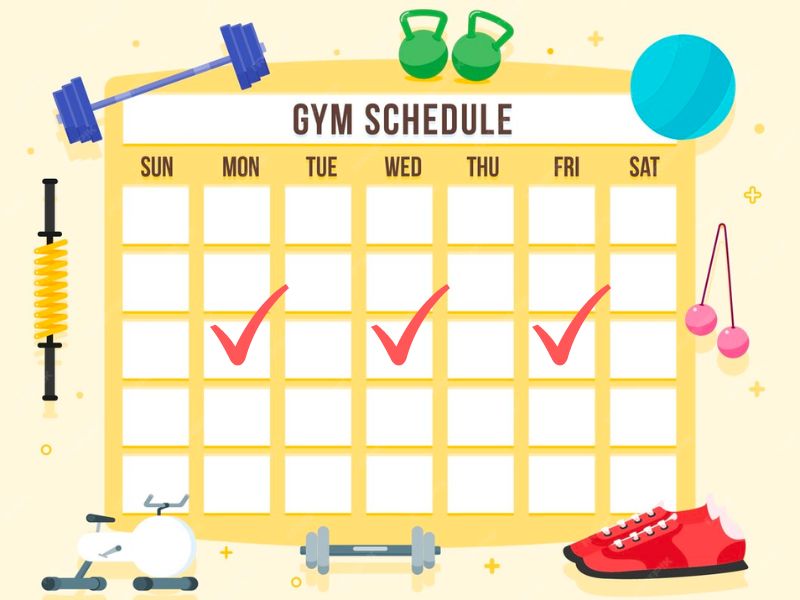
Periodization is like a roadmap for your training journey. It divides your workouts into specific phases, each with a distinct focus. Think of it like this:
- Strength Phase: Time to channel your inner weightlifting champion! This phase involves lifting heavier weights (think 6-8 reps) for fewer sets. This stimulates muscle growth and builds raw strength, the foundation of your fitness pyramid.
- Hypertrophy Phase: Now, let’s focus on sculpting those muscles! This phase is all about maximizing muscle building [*]. You’ll lift moderate weights (8-12 reps) for more sets, pushing your muscles to fatigue. Imagine them getting nice and sore (in a good way!).
- Power Phase: Ever wanted to explode with power during your workouts? This phase uses lighter weights (1-3 reps) at high velocity. It trains your nervous system to fire on all cylinders, helping you unleash explosive movements like jumping higher or sprinting faster.
Advanced Techniques: Unlocking Your Training Potential
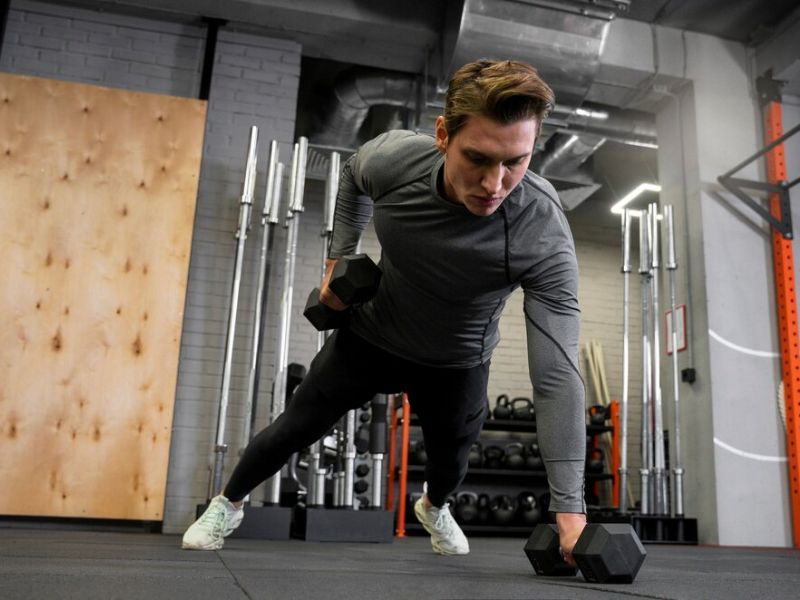
Ready to spice things up and break through plateaus? Let’s explore some advanced training techniques that can take your workouts to the next level:
- Supersets: Imagine a tag-team match between exercises. Supersets involve performing two exercises BACK TO BACK with minimal rest, targeting different muscle groups. This intensifies your workout and saves time, making you a gym efficiency expert.
- Hybrid Sets: Ever feel like mixing things up? Hybrid sets combine two exercises into one fluid movement. Think of it as a creative combo. For example, you could perform a bicep curl followed immediately by a shoulder press, working multiple muscle groups simultaneously.
- Circuit Training: Get ready to move like a machine! Circuit training involves moving through a series of exercises with minimal rest in between. This keeps your heart rate up and maximizes calorie burn, turning your workout into a fat-burning inferno.
Tracking Progress: Your Roadmap to Success
Just like a GPS helps you navigate, tracking your progress helps you stay on track and motivated. Here’s what to focus on:
- Weight Lifted: Track the weight you lift for each exercise. As you get stronger, aim to gradually increase the weight to keep challenging your muscles. Don’t be afraid to push your limits (safely, of course!).
- Sets and Reps: Monitor the number of sets and repetitions you perform for each exercise. This helps you gauge workout intensity and adjust accordingly. Think of it as finding the sweet spot that challenges you without risking injury.
- Body Measurements: Take measurements of key areas like your chest, arms, and thighs periodically. While the scale might not always reflect your progress (muscle gain can sometimes offset weight loss), noticing changes in body composition can be a great motivator.
Dispelling myths about weight training and bulking.
Let’s face it, stepping into the weight room can be intimidating. You might be picturing scenes from movies where bodybuilders grunt and lift colossal weights.
Maybe you’ve heard whispers about getting bulky, hurting yourself, or it being just for a specific body type.
But what if those were just myths holding you back from the incredible benefits of strength training?
Let’s shed some light on these common misconceptions and show you the beautiful truth about resistance training.
Myth #1: Lifting Weights Makes You “Look Like a Man”

This one can be a real confidence crusher, especially for WOMEN. But here’s the science: building significant muscle mass requires a very specific training approach and, frankly, a lot of effort.
Most women who embrace strength training experience a toned, sculpted physique, not a bulky one. Strength training can help you achieve that coveted “strong is the new skinny” look and feel powerful in your skin.
Myth #2: Strength Training is Just About Looking Good
Strength training goes way beyond aesthetics:
- Boost Bone Density: This is especially important for women as they age, helping to prevent osteoporosis.
- Reduce Risk of Chronic Diseases: Strength training can help manage blood sugar levels, improve heart health, and even lower your risk of certain cancers.
- Improve Mood and Reduce Stress: Exercise releases endorphins, those feel-good chemicals that can combat stress and anxiety. Strength training can leave you feeling empowered and energized.
Myth #3: You Need Fancy Equipment and a Gym Membership

The beauty of strength training is its accessibility. You can achieve amazing results with just your bodyweight. Exercises like squats, lunges, push-ups, and planks can be done anywhere, anytime.
As you progress, consider adding dumbbells, resistance bands, or even water bottles for an extra challenge. Many free workout videos online can guide you through bodyweight routines.
Myth #4: Strength Training Takes Up Too Much Time
We all lead busy lives, but strength training doesn’t have to eat up your entire day.
You can get a fantastic full-body workout in as little as 30 minutes, 2-3 times a week. Consistency is key, but even shorter sessions can make a big difference.
Myth #5: Strength Training is Intimidating and I Don’t Know Where to Start
Feeling lost in the weight room is normal, especially for beginners. Here are some tips to ease into strength training:
- Start with Bodyweight Exercises: Master bodyweight exercises like squats and lunges before adding weights.
- Find a Buddy: Having a friend join you can boost motivation and keep you accountable.
- Consider Working with a Trainer: Even a few sessions with a personal trainer can teach you proper form and create a personalized plan.
Conclusion
In conclusion, strength training is a powerful tool that can transform your body and mind. It goes beyond just weight loss, building a stronger, healthier you.
From boosting your metabolism and strengthening your bones to improving your mood and reducing stress, the benefits are undeniable.
So ditch the myths, embrace the challenge, and embark on your strength training journey.
You might be surprised by what you can achieve. Remember, consistency is key, and with dedication and the right guidance, you’ll be well on your way to reaching your fitness goals and feeling your strongest self.


you are in reality a good webmaster The website loading velocity is amazing It sort of feels that youre doing any distinctive trick Also The contents are masterwork you have done a fantastic job in this topic